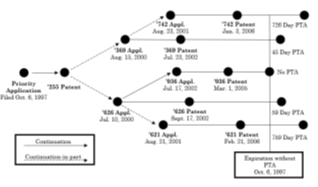Here’s a familiar scenario. An applicant files a first patent application with medium-to-narrow claim coverage. The first patent application issues with some or substantial patent term adjustment (PTA) caused by one or more delays at the U.S. Patent and Trademark Office (e.g., Patent A – earlier-filed and later-expiring patent). The applicant subsequently files a second patent application – continuation or continuation-in-part –with patentably indistinct claims from those secured in Patent A. The second patent application issues with no or less PTA than Patent A (e.g., Patent B – later-filed and earlier-expiring patent).
Is Patent A safe from an ODP challenge in view of Patent B? And what if Patent B has expired?
Based on the precedential decision in In re Cellect, LLC, the U.S. Court of Appeals for the Federal Circuit (CAFC) made clear that Patent B (later-filed and earlier-expiring patent) can be used to challenge Patent A (earlier-filed and later-expiring patent family member due to PTA) on grounds of ODP.[1] And if Patent B has expired, a terminal disclaimer cannot be used to cure an ODP rejection applied against Patent A. In other words, Patent A would be invalid in view of the ODP rejection. As the CAFC put it, “[a] terminal disclaimer is not an escape hatch to be deployed after a patent expires.”[2] Emphasis added.
***
History
This case stems from four ex parte reexaminations respectively challenging four related patents on grounds of ODP. ODP was not raised by the examiner during prosecution of the challenged patents. Each challenged patent accrued PTA, and none was subject to a terminal disclaimer during prosecution.[3]
A final office action was issued in each reexamination proceeding indicating the challenged claims were obvious variants of the prior-expiring reference patent claims. The patentee, Cellect, appealed the claim rejections to the Patent Trial and Appeal Board (PTAB). Cellect did not dispute the obviousness aspects of the examiner’s ODP rejections. Rather, Cellect argued the rejections were improper on other grounds. One of Cellect’s grounds suggested PTA should be considered similar to patent term extension (PTE) in the context of ODP in view of Novartis AG v. Ezra Ventures LLC.[4] Cellect also challenged the findings of a substantial new question of patentability (SNQ). According to Cellect, ODP was already considered since the examiner prosecuted and was aware of all the challenged and referenced patents without rejecting any under ODP.
The PTAB sustained the examiner’s findings of unpatentability of the claims under ODP in each of the four reexaminations. Cellect appealed to the CAFC.
Based on the arguments raised by Cellect, the CAFC indicated PTA and PTE should be treated differently at least since they are captured under different statutes and cover distinct circumstances. In contrast with PTE, which is governed under 35 U.S.C. §156, the CAFC noted how 35 U.S.C. §154(b)(2)(B) shows congressional intent of terminal disclaimers and ODP in the context of PTA. Accordingly, the CAFC concluded, “ODP for a patent that has received PTA, regardless whether or not a terminal disclaimer is required or has been filed, must be based on the expiration date of the patent after PTA has been added.”[5]
Regarding Cellect’s argument on SNQ, the CAFC identified the prosecution histories of the challenged patents being devoid of any examiner consideration regarding an ODP rejection. The CAFC noted the absence of any terminal disclaimers provides a strong indication the examiner did not consider the issue of ODP during prosecution.[6] The CAFC also reminded that 35. U.S.C. § 303(a) makes clear that an SNQ is not automatically precluded by the fact that a patent or printed publication was previously cited by or to the USPTO, or considered by the USPTO.[7]
***
Strategic Considerations
This may be an opportune time for patent owners to audit their portfolios to evaluate and recognize the potential risks impacting issued patent claims in a family with one or more related cases. Depending on commercial and other strategic objectives, consideration should be given whether to proactively file any terminal disclaimers – assuming common ownership – to prevent third-party ODP challenges, particularly before expiration of the earliest-expiring patent in the particular family. On the other hand, third-party challengers should be mindful of the expiration dates and ownership of all patents in the family. Doing so will help evaluate the strengths and weaknesses of an ODP challenge potentially cutting short valuable patent term or invalidating claims of the patent. Separately, those tasked with managing and developing portfolios should be keenly aware of the risks in filing continuing applications where the claims are not patently distinct from other claims in the patent family.
[1] In re Cellect, LLC, No. 2022-1293 (Fed. Cir. Aug. 28, 2023).
[2] Id. at 25.

[3] Id. at 4
[4] Novartis AG v. Ezra Ventures LLC, 909 F.3d 1367 (Fed. Cir. 2018).
[5] In re Cellect, LLC at 21.
[6] Id. at 25.
[7] Id. at 24.
[View source.]